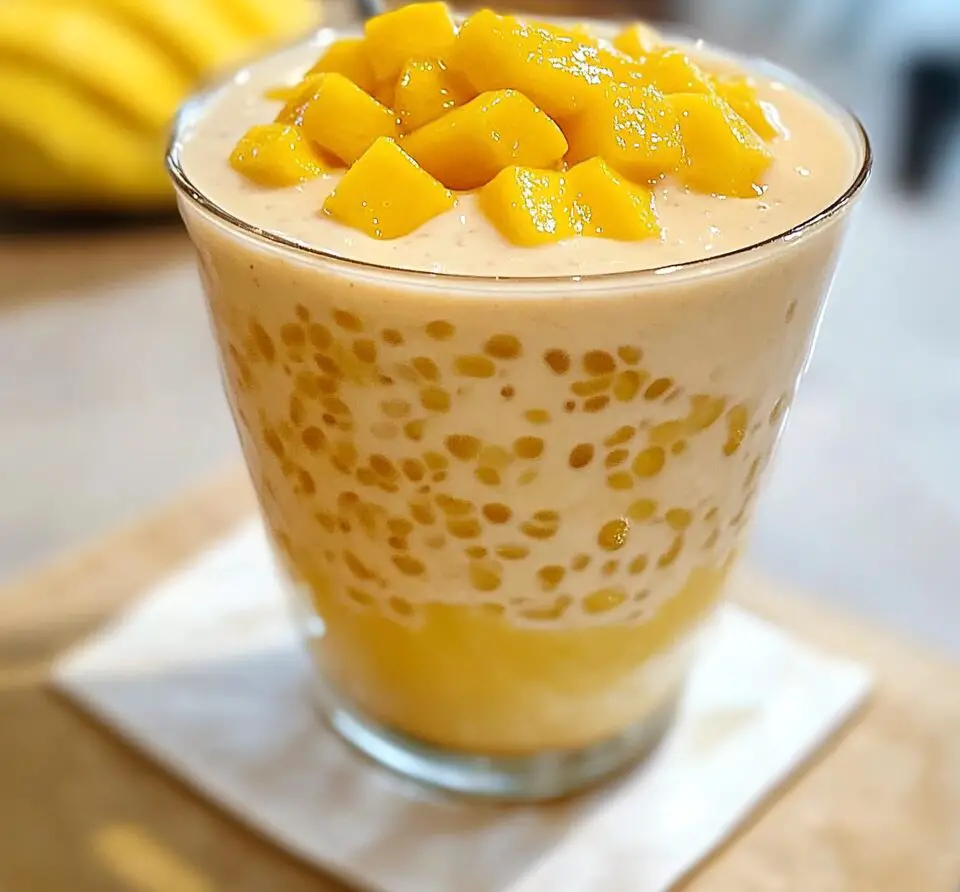The Origins and Popularity of Mango Sago
Mango Sago likely traces its roots to Hong Kong or Singapore, where sago-based desserts are common in Cantonese cuisine. Traditionally served in dessert houses or as a light finish to a dim sum feast, mango sago is cherished for its sweet tropical flavors and cool, silky texture.
Its popularity has since spread across Asia and beyond, with countless regional variations. Some versions are blended into a mango smoothie consistency, while others are more pudding-like or include chunks of jelly or pomelo. Despite the variations, the core concept remains consistent: creamy, fruity, and loaded with tapioca pearls.
Today, mango sago is beloved not just for its taste, but also for its versatility and presentation. Whether served in glass cups for elegant dinner parties or scooped into bowls for casual enjoyment, it’s always a hit.
Why This Dessert Works
The success of Creamy Mango Sago lies in the harmony of its components. Ripe mango provides the unmistakable sweetness and bright tropical flavor, while coconut milk lends creaminess and a subtle nuttiness that perfectly complements the fruit. Condensed milk adds smooth richness and sweetness without needing additional sugar. Tapioca pearls provide an exciting chewy texture, transforming the dessert into an experience of contrasting elements.
This dessert is chilled, making it especially refreshing on hot days. Its make-ahead nature means it’s ideal for prepping in advance of events or as a meal-prep dessert that keeps well for several days in the fridge.
Best of all, the ingredients are easy to find and budget-friendly. You can use fresh mangoes when in season or opt for frozen or canned mango pulp year-round.
Nutritional Benefits
While mango sago is undeniably indulgent, it also offers a few nutritional perks—especially when made with fresh, natural ingredients.
Mangoes are rich in vitamin C, vitamin A, and antioxidants like beta-carotene, which support immune health, eye function, and skin glow. They’re also high in dietary fiber and enzymes that can aid digestion.
Coconut milk, especially when used in moderation, offers healthy fats—mainly medium-chain triglycerides (MCTs)—which are more easily metabolized by the body and can provide quick energy. It also contains essential minerals like manganese and copper.
Tapioca pearls are low in fat and sodium, although they are primarily a carbohydrate source, making them a good energy booster when consumed mindfully. When served with moderation and balance, mango sago can be a more natural alternative to sugary, processed desserts.
For a lighter version, you can substitute full-fat coconut milk with light coconut milk or even almond milk. To reduce refined sugar, you can skip the condensed milk and use natural sweeteners like honey, agave, or coconut sugar, or simply rely on the sweetness of very ripe mangoes.
Tips for Best Results
To create the most flavorful mango sago, start with ripe, juicy mangoes. Look for mangoes that give slightly when pressed and have a sweet aroma. Ataulfo (honey mango) or Alphonso varieties are ideal due to their rich flavor and smooth texture.
Cook tapioca pearls gently to prevent them from becoming too mushy or sticking together. Stir frequently while boiling, and rinse immediately with cold water to stop the cooking process and keep them chewy and distinct.
Blend part of the mango with the condensed and coconut milk until velvety smooth—this becomes the base of your dessert. For more texture and contrast, reserve some diced mango for topping. If you prefer a thinner consistency, add a splash of evaporated milk or more coconut milk.
Chill thoroughly before serving. The dessert becomes more flavorful after sitting for an hour or two in the refrigerator, allowing the tapioca to absorb some of the sweetness and the flavors to meld beautifully.
Creative Variations
Mango Sago is wonderfully customizable. Here are a few fun ways to change it up:
Pomelo Mango Sago: Add chunks of fresh pomelo or grapefruit for a tart, citrusy contrast that cuts through the richness.
Mango Sago Smoothie Bowl: Blend all ingredients and pour into a bowl topped with fresh mango, chia seeds, shredded coconut, or granola.
Mango Coconut Jelly Sago: Incorporate cubes of coconut jelly or grass jelly for added texture and visual interest.
Vegan Mango Sago: Use sweetened coconut condensed milk or a combination of coconut cream and maple syrup in place of dairy-based condensed milk.
Thai-Inspired Mango Sago: Add sticky rice and toasted sesame seeds or peanuts for a twist reminiscent of Thai mango sticky rice.
Serving Suggestions
Creamy Mango Sago is best served cold, preferably in individual dessert cups, glass jars, or even hollowed-out coconuts for a dramatic touch. Garnish with extra mango chunks, mint leaves, or a sprinkle of toasted coconut flakes for added flair.
It pairs beautifully with other tropical desserts like coconut pudding, pandan chiffon cake, or lychee jelly. It’s also a wonderful finisher after a light Asian meal, balancing savory flavors with its creamy sweetness.
If serving for a crowd, you can double the recipe and serve it in a chilled trifle dish or glass bowl with a ladle for self-service.
Storage and Make-Ahead Tips
Mango Sago keeps well in the refrigerator for up to 3 days, though the texture of the tapioca pearls is best within the first 24–48 hours. Store in an airtight container and stir gently before serving, as some separation may occur.
Avoid freezing, as the texture of both the tapioca pearls and the coconut milk may become grainy or rubbery when thawed.
If you’re preparing in advance, keep the diced mango separate and add it just before serving for optimal freshness and texture.
Conclusion
Creamy Mango Sago is the kind of dessert that surprises and delights—simple to make, stunning to serve, and irresistible to eat. With the rich essence of mango, the tropical charm of coconut milk, and the playful texture of tapioca pearls, it captures everything we love about warm-weather sweets in one chilled, creamy bowl.
Whether you’re preparing it for guests, making a treat for your family, or simply indulging your sweet tooth, this dessert delivers both flavor and satisfaction. It’s a perfect fusion of Asian tradition and modern ease, proving that with just a few ingredients, you can create something truly memorable.
Keep this recipe in your back pocket for any time you need a dessert that’s equal parts comforting, refreshing, and undeniably delicious.








